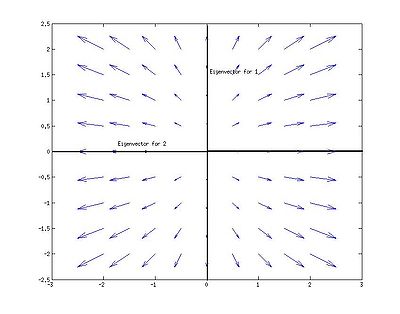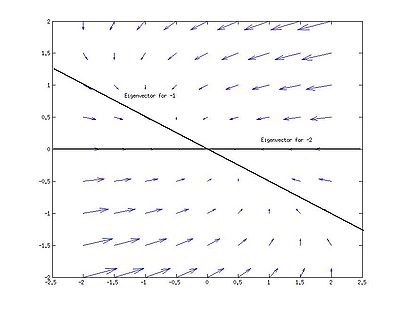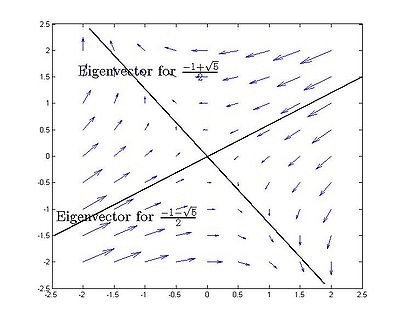|
Using the Jacobian from 7 (b) we find the linearization of the system in the critical points.
Critical point 

- This matrix is diagonal and so the diagonal elements are the eigenvalues
- This matrix is positive definite since its two eigenvalues
 are positive. All positive eigenvalues indicate that the critical point are positive. All positive eigenvalues indicate that the critical point  is an unstable node. is an unstable node.
- The eigenvector for the eigenvalue
 is is  . .
- The eigenvector for the eigenvalue
 is is  . .
- The linearized critical point in the phase space is on the following figure:

Critical point 

- The eigenvalues are
 , because a triangular matrix has its eigenvalues on the diagonal. The eigenvalues are both negative and hence, the matrix is negative definite and this critical point is a stable node. , because a triangular matrix has its eigenvalues on the diagonal. The eigenvalues are both negative and hence, the matrix is negative definite and this critical point is a stable node.
- The eigenvector for the eigenvalue
 is is  because of the triangular shape of the matrix. because of the triangular shape of the matrix.
- For the other eigenvector we need to work a little more and calculate the null space of
 : :

Hence, 
- We find the the eigenvector for
 is is  . .
- The linearized critical point in the phase space is on the following figure:

Critical point 

- For the eigenvalues we calculate


- The eigenvalue for
 is the null space of is the null space of


so that the eigenvector is  . .
- The eigenvalue for
 is the null space of is the null space of


and the eigenvector is  . .
- Because one eigenvalue is positive, the other negative, the critical point is not asymptotically stable. Along the eigenvector for
 , the solution moves away from the critical point, along the eigenvector for , the solution moves away from the critical point, along the eigenvector for  , the solution moves towards the critical point. Since the eigenvalues do not have the same sign, the matrix is indefinite and the equilibrium is a saddle point. , the solution moves towards the critical point. Since the eigenvalues do not have the same sign, the matrix is indefinite and the equilibrium is a saddle point.
- See the following figure:

|

































